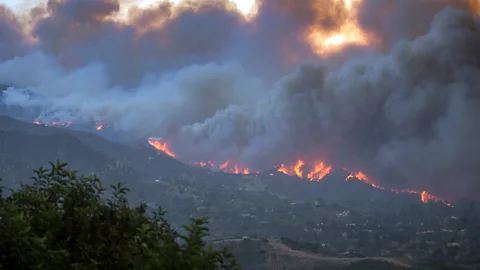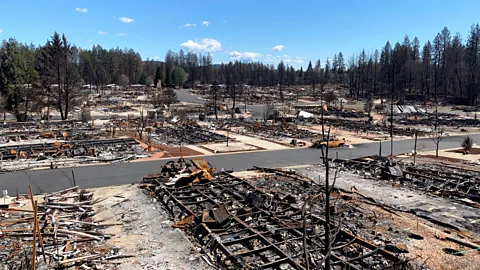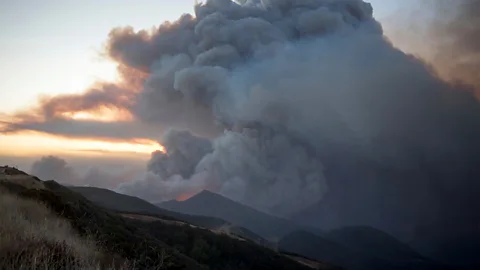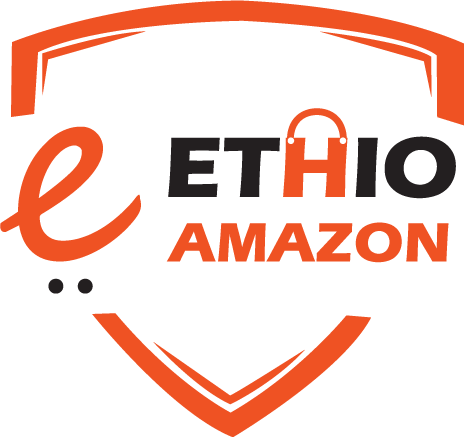The California town that kept a record-breaking wildfire at bay Leave a comment
In 2017, one of California’s largest ever wildfires was steadily approaching Montecito. But it had long been preparing for just such an event, and survived almost intact.
A few days into December 2017, Maeve Juarez, a wildland fire specialist for the Montecito Fire Department, learned an enormous wildfire was creeping toward the Southern California town.
She was about to be on the frontlines of a community of less than 10,000 people facing off against the Thomas Fire, California’s largest ever wildfire at that time.
The community, however, had several advantages over the approaching fire, the most significant being that it had been preparing for this moment for 30 years.
A decades-long programme had ensured people in the town took regular measures – from clearing up dried leaves around town to fire-proofing their own houses – and installed a level of community trust and cohesion that made fast action possible in the face of a quickly encroaching fire.
As climate change brings the wildfire threat closer to many communities, they are likewise considering what measures they can take to protect themselves. They may not have 30 years to develop these strategies, but looking at Montecito’s long-running experiment can help other communities come up with plans of their own.
“You don’t start preventing dementia once the signs are there; similarly, we don’t want to start preparing for wildfire once it’s coming into our neighbourhoods,” says Juarez.
A long night
On 16 December 2017, the Thomas Fire’s flames emerged above Montecito, almost a full week after residents had evacuated. By then, the Sundowner winds – strong down-sloping winds that typically hit the area in the early evening – reached 65mph (105km/h) and the fire team braced for the worst.
But Montecito’s long history of preparation, along with the support of over 8,000 firefighters, turned the town into a wildfire success story.
As the fire peaked around 6am, firefighter reservers came to help the crews positioned to keep the fire at bay. Over the next 12 hours, they worked together fighting spot fires that cropped up from falling embers. By nightfall, the Sundowner winds had died down, and the fire had moved away from the coastline and Montecito. As the Thomas Fire’s flames emerged above Montecito, the town’s firefighters braced for the worst (Credit: Kari Greer)
As the Thomas Fire’s flames emerged above Montecito, the town’s firefighters braced for the worst (Credit: Kari Greer)
Despite the ominous setup, the town’s extensive preparations had paid off. The Thomas Fire burnt through some 282,000 acres (114,000 hectares) of Californian land, including parts of nearby Ventura and Santa Paula. But once the flames and embers abated, only seven homes in Montecito had burned down.
“Hundreds of structures benefited from the vigilant fire suppression resources that had been deployed in advance,” says Juarez. “The level of damage was considerably lower than projected in the 2016 Montecito community wildfire protection plan or what we experienced during previous fires.”
A unified approach
Montecito’s long journey to that moment started in 1994 when, prompted by worsening wildfire seasons, the Montecito Fire Department launched a programme led by wildland fire specialists to develop ways to mitigate wildfire threats. Since then, they have consistently helped the community come together to maintain these strategies as a united front.
With the guidance of wildland fire specialists like Juarez, community members have long been asked to take critical steps to reduce fire fuel (such as dried leaves and dead plants) around the town. The fire department organises regular neighbourhood cleanups, offers free wood-chipping services, and clears overgrowth and brush in remote areas that might help spread wildfire.
They also have a comprehensive evacuation plan in place to protect residents and clear the way for first responders to do their job. Community members are kept up to date on the best fire mitigation practices, such as how to incorporate new fire-resistant materials into home hardening projects.
“Our strength lies in ensuring that our entire community is prepared for wildfires,” says Juarez. “While following all the recommended checklists is essential, the community’s collective efforts are what truly make the difference.”
The other major advantage Montecito had during the Thomas Fire was time. Due to how the fire was moving, they were able to deploy firefighting resources (130 engines and 30 crews) four days before the fire encroached on the town.
They even had the bandwidth to use bulldozers to clear vegetation along a perimeter above and around Montecito, which is known to burn quickly, while water tankers spread retardant across around 16 miles (26km) of upper roadways.
Time also helped them to implement a calm, measured evacuation, although this also owed something to the town’s long-standing preparations for wildfire, Juarez says.
The established trust between the fire department’s wildland fire specialists and the community led to high compliance with evacuation orders, meaning firefighters had the chance to clear brush.
Willingness to follow requests to leave private driveway gates open, meanwhile, meant firefighters could strategically set up fire trucks and hose lays around individual properties.
Wildfire risk: where to start
Wildfires in the Western US are growing bigger and more intense as climate change triggers longer, dryer summers. But that just sets the stage; urban sprawl and accidental ignition by humans also increase the risk of megafires by creating more fuel and then lighting the match, so to speak.
Erica Fischer, assistant professor of structural engineering at Oregon State University in the US, studies how community infrastructure is impacted by natural disasters, with a particular focus on wildfires and earthquakes. She says the science behind how communities can be retrofitted to withstand wildfires is some 100 years behind that of withstanding earthquakes.
If a community doesn’t have a unified, collaborative mitigation strategy, she says, the burden often falls entirely on individual homeowners.
So, where can communities without a wildfire mitigation strategy begin? Fischer says the first step is to identify their most vital infrastructure and develop a plan to protect it from burning – a strategy known as asset mapping.
“What would burn in this community that would destroy it economically [and] prevent it from coming back?” says Fischer. “Previous research shows that [it’s] often schools and hospitals, particularly if they only have one of them in a town, which means that they’re usually the largest employers.”
 A willingness to follow requests to leave private driveway gates open allowed firefighters to set up fire trucks and hose lays around individual properties (Credit: Kari Greer)
A willingness to follow requests to leave private driveway gates open allowed firefighters to set up fire trucks and hose lays around individual properties (Credit: Kari Greer)Every community is different and will have a unique set of priorities. In Ashland, Oregon, for example, which is currently developing its wildfire mitigation strategy, the town prioritised protecting its theatre, Fischer says.
Identifying areas where fire is likely to spread is also a high priority. For example, if there’s an older wooden church in the centre of town that could quickly catch fire if embers fell on it, that should be hardened against fire first.
Meanwhile, protecting water infrastructure should not be overlooked, stresses Fischer. “There’s been a lot of water infrastructure damage throughout the West due to wildfires, and that includes contamination within the water distribution system.” One helpful approach is to create defensible spaces around water supplies, such as natural watersheds and reservoirs.
All parts of a community need to understand their own level of risk, adds Abby Silver, outreach programme coordinator for Wildfire Partners, a non-profit in Boulder County, Colorado. “Before the Marshall Fire [in Boulder, Colorado in 2020], those who lived in the more urban parts of the east county thought of wildfire as something that happens ‘up there in the hills’,” says Silver. Now they’re beginning to realise that wildland fire can turn into urban conflagration under the right conditions.”
Extra effort may be needed to include and support parts of the community likely to have a harder time recovering if they lost structures in a wildfire. Financially and/or socially vulnerable areas might not have as direct access to firefighting resources as more affluent parts of a community, says Fischer, nor as much representation in a town hall setting. Mobile homes are highly combustible and parks are vulnerable during wildfires, as seen in this case during the 2018 Camp Fire in California (Credit: Erica Fischer)
Mobile homes are highly combustible and parks are vulnerable during wildfires, as seen in this case during the 2018 Camp Fire in California (Credit: Erica Fischer)
Experts agree that every wildfire-at-risk community needs a concise evacuation plan that is broadcast widely and accessible to all community members. If a community can be efficiently evacuated ahead of a wildfire, it clears the way for firefighters and emergency crew to do their job.
“During a wildfire, emergency responders’ first priority is life safety, then structure defense,” says Silver. “The less energy they have to devote to helping residents evacuate, the more they can devote to response. Educating the public to evacuate early, without necessarily waiting for an evacuation order, facilitates the work of first responders.”
No panacea
Connecting people, stories and ideas to spread fire adaptation practices to different communities and help with peer support play an important role, too, says Emily Troisi, director of the Fire Adapted Communities Network (FacNet), a non-profit that helps provide fire-at-risk communities with the education and tools they need to better mitigate the impacts of fires. “This work is very hard, [and] complex, and many communities have experienced trauma from the severe negative impacts of extreme wildfire.”
Doing retrospectives of towns that were destroyed or partially destroyed by wildfires, unlike Montecito, can also help communities see where the gaps in protection were, says Fischer. This, in turn, can help them prioritise what they need to shore up. “These towns where portions of the towns were down, those are the real success stories that we should be engaging with and talking about a little bit more.”
However, Fischer cautions that Montecito’s mitigation strategies aren’t a panacea that will work for every fire-at-risk community. “When [you’ve been] doing this staged approach [for 30 years], not only is it not so much of a financial burden to the community itself, but you’re doing a little bit over a long period of time, and that changes the culture and the perception of risk and hazard within the town.”
Most communities in the US are also not as homogenous as the small, affluent town of Montecito. It’s challenging to get everyone in a community on board with a complex wildfire mitigation plan, even with incremental change, when there’s economic and social disparity.
“To tell a community that you need to do all of this wildland mitigation in addition to all of this mitigation within your community, and you need to do it immediately, or else your town is going to burn down? It’s overwhelming, financially,” says Fischer.
Troisi also advises against putting too narrow a focus on only preventing fires or stopping structures from burning. FacNet focuses on tools that aid overall community evaluation and relationship-building to help people think through who and what needs to be included in resilience efforts, she says. The 2017 Thomas Fire was the largest in recorded Californian history at the time, but has since been surpassed in size by eight others (Credit: Kari Greer)
The 2017 Thomas Fire was the largest in recorded Californian history at the time, but has since been surpassed in size by eight others (Credit: Kari Greer)
Understandably, not every community has the budget to develop an expensive wildfire mitigation programme. However, Juarez says, there are several grants available that include salaries for wildland specialists like her. Numerous non-profits around the US are also helping at-risk communities become more fire aware.
Fires can be incredibly destructive, but they can also be beneficial if handled respectfully. Prescribed burns are often instrumental in reducing the risk of megafires, according to a 2023 report from the Wildland Fire Mitigation and Management Commission, which gave recommendations to Congress on how to improve federal policies related to wildland fires. (Read more about the benefits of prescribed burns for nature).
Beyond a fire-proof home
While experts advise communities to harden their homes against wildfires collectively, there are also several steps individual homeowners can take to make their property less likely to catch fire.
According to Juarez, quick and impactful measures include retrofitting vents with galvanised steel screening; filling and covering exposed wood on siding, doorways and windows with caulk and fresh paint; and sealing garages and doors with weather stripping. She also recommends installing gutter screens since gutters can collect dry leaves and debris that ignite easily. In all cases, it’s important to use ignition-resistant construction materials whenever possible.
CARBON COUNT
The emissions from travel it took to report this story were 0kg CO2. The digital emissions from this story are an estimated 1.2g to 3.6g CO2 per page view. Find out more about how we calculated this figure here.
Perhaps the most impactful step homeowners can take is to create a buffer zone around their property (the recommended buffer area can vary depending on a state’s wildfire risk; in California, the zone is 100ft (30m).
“Use non-combustible materials like pebbles or river rock within the first 5ft (1.5m) of your home,” says Juarez. “This area should have little to no vegetation to minimise anything that could catch fire from embers.” Clearing flammable materials, such as brush and weeds, beyond this zone is also a good idea.
But as Montecito shows, wildfire protection goes far beyond these individual measures. As climate change fans the flames of wildfire destruction further, mitigation experts say it takes connections and continued, active participation between everyone to develop defensive strategies that will work.
“It has to be a collaboration between land management agencies, governments, and homeowners,” says Fischer. “All three have to buy in, and all three need to be at the table ready to do something.”
If you are looking to order local products, handcraft, custom clothes, various books, handmade arts, furniture’s, food spices etc. please, visit our web page at www.ethio-amazon.com. Or send us your request at email contact@ethio-amazon.com you can also contact us on WhatsApp at +2519-44-36-97-53Additionally, if you would be interested to socialize and looking for a new friend around the world, for future partnership… visit our web page at www.contactyourlifepartner.com
We believed that love can happen anytime, anywhere in a world filled with endless possibilities… for more information contact us at Email contact@ethio-amazon.com or Call us at +2519-44-36-97-53 (WhatsApp) , + 6676539901 (international)
Source ( BBC News )

